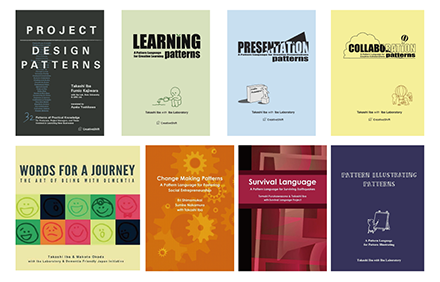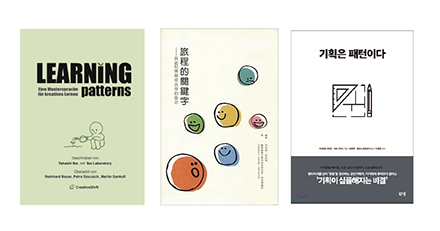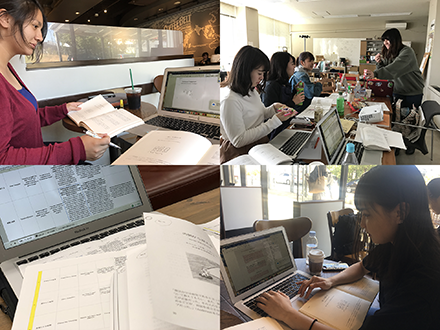Seminar Syllabus: Iba Lab B, 2020 Fall
Iba Lab B
Translating Pattern Languages into Various Languages
(Thursday 2nd period, 2020 Fall semester)
Entry submission deadline: July 19
We live in a complex and changing society, and the future will be determined by and based on our current actions and experiences. Therefore, methodologies and tools regarding the creation of a future where we can live well are significant. The research conducted in Iba lab consists of creating and sharing “pattern languages” throughout the world as these sorts of methodologies and tools.
Pattern language is the method of and the tool for identifying common patterns of good practices embedded in specific domains and sharing this wisdom with others. It was originally proposed in the domain of architecture in the 1970s and has since been applied to various other domains such as software development, education and organizations.
For the past 10 years, Iba Lab has created over 70 pattern languages on diverse topics that provide tacit practical knowledge of creative human actions, comprising over 1700 patterns in total. Topics include the following: learning, collaboration, presentation, project design, open dialogue, education, reading, cooking, living well with dementia, living well with working and parenting, employment of people with disabilities, welfare innovation, management of child care, social entrepreneurs, value-creation marketing, change making, community innovation, hospitality, life transition, beauty in everyday life, natural living, disaster prevention and public policy design. These pattern languages have been practically utilized to improve practices and generate dialogues among people in various organizations and communities.

Some of these pattern languages have been translated to languages such as Traditional Chinese, Korean and German and published as books overseas. An even larger number of these pattern languages have been published in English and are being used in other countries, with one even being written about in a newspaper in the UK. Our pattern languages are known throughout the world and have gathered many fans. However, with the majority of our pattern languages only available in Japanese or English, we are not yet able to reach out to the ordinary people of many countries.

In Iba Lab B we plan to work on improving this current situation by translating Iba Lab’s existing pattern languages. The translating of works of art are fundamentally considered to be “re-creations,” a work in one language re-created into a different language. García Márquez, the prominent novelist who received the Nobel Prize in Literature 1982, said “A good translation is always a re-creation in another language.” Because pattern languages are “languages,” this concept of “re-creating” the language is even more significant.
In Iba Lab B, students will learn the knowledge necessary for creating pattern languages (which are essential in re-creation as well) and in addition, work on actually translating pattern languages. There are two main types translating that will take place: (1) Translating from English (or Japanese) to Another Language, and (2) Translating from Japanese to English.
(1) Translating from English (or Japanese) to Another Language
This is for students whose native tongue is neither Japanese nor English. You will translate pattern languages written in English (or Japanese) to languages such as Chinese, Korean, Vietnamese, Malay, Indonesian, Thai, German, French, Spanish, Russian, etc. and gather the finished translation into a booklet. We will then continue by sharing and using these translations in countries or regions that use that language and, if possible, publishing them overseas. Additionally, we would like to hold dialogue workshops both in Japan and overseas using these translated pattern languages.
(2) Translating from Japanese to English
This is for students who can fluently read Japanese. You will translate pattern languages written in Japanese to English. We will aim to publish these English translations as books. Additionally, we would like to hold dialogue workshops both in Japan and overseas using these translated pattern languages.

Iba Lab puts an emphasis of a learning style we call “Creative Learning,” in other words, “learning by creating” and “learning through creating.” This is a learning style in which, by taking part in a creative practice where one makes something, one can construct knowledge within themselves while deepening their understanding of things and gaining new ideas. In Iba Lab B, we will deepen our understandings of what pattern languages are and what is important in making them by translating (re-creating).
If anyone would like to create their own original pattern language after gaining experiences re-creating with translations, you can consult with Prof. Iba about when and how that can be done.
Number of Students
15
Requirement
The theme for our lab is creativity. We are looking for prospective lab members who are willing to commit creatively to the future!
Class Schedule
Official meeting will be on 2nd period of Thursday.
Members are required to work on their projects outside of class time.
Screening Schedule
Entry submission deadline: July 19
Entry Assignment
After reading through this syllabus thoroughly, please submit the entry assignment described below via email by July 19.
Email to: ilab-entry [at] sfc.keio.ac.jp (Please change [at] to @)
Subject: Iba Lab B (2020 Fall) Entry
Please attach your entry assignment in a Word, Pages or PDF file.
Iba Lab B (2020 Fall) Entry
1. Name, Faculty, Grade, Student ID, e-mail address
2. Profile photo
3. introduction of yourself (interests, future visions, Circles, activities, any other points to sell)
4. Reason for your entry into Iba Lab, and your enthusiasm towards the research activity in Iba Lab
5. Your native language and languages you can write well
6. Skills/ things you are good at (graphic design, film editing, programming, music, etc.)
7. Courses by Prof. Iba which you have taken before (if any)
8. Favorite classes you've taken so far (Multiple answers are welcome)
9. Labs (Kenkyukai) you have been a part of (if any)
10. Other Labs (Kenkyukai) you are planning on joining next semester (if any)
Assesment Method
Grading will be based on participation, project, and final product.
Materials & Reading List
References
Pattern Languages Iba Lab created and published in English
Pattern Languages Iba Lab created and published in other languages
Important Introductory Papers from Iba Lab
Other papers and information is provided at this page.
Related Courses
PATTERN LANGUAGE (GIGA)
DESIGNING SFC SPIRITS (GIGA)
Iba Lab A
Contact
ilab-entry [at] sfc.keio.ac.jp
Iba Lab B - Translating Pattern Languages into Various Languages
Translating Pattern Languages into Various Languages
(Thursday 2nd period, 2020 Fall semester)
Entry submission deadline: July 19
We live in a complex and changing society, and the future will be determined by and based on our current actions and experiences. Therefore, methodologies and tools regarding the creation of a future where we can live well are significant. The research conducted in Iba lab consists of creating and sharing “pattern languages” throughout the world as these sorts of methodologies and tools.
Pattern language is the method of and the tool for identifying common patterns of good practices embedded in specific domains and sharing this wisdom with others. It was originally proposed in the domain of architecture in the 1970s and has since been applied to various other domains such as software development, education and organizations.
For the past 10 years, Iba Lab has created over 70 pattern languages on diverse topics that provide tacit practical knowledge of creative human actions, comprising over 1700 patterns in total. Topics include the following: learning, collaboration, presentation, project design, open dialogue, education, reading, cooking, living well with dementia, living well with working and parenting, employment of people with disabilities, welfare innovation, management of child care, social entrepreneurs, value-creation marketing, change making, community innovation, hospitality, life transition, beauty in everyday life, natural living, disaster prevention and public policy design. These pattern languages have been practically utilized to improve practices and generate dialogues among people in various organizations and communities.

Some of these pattern languages have been translated to languages such as Traditional Chinese, Korean and German and published as books overseas. An even larger number of these pattern languages have been published in English and are being used in other countries, with one even being written about in a newspaper in the UK. Our pattern languages are known throughout the world and have gathered many fans. However, with the majority of our pattern languages only available in Japanese or English, we are not yet able to reach out to the ordinary people of many countries.

In Iba Lab B we plan to work on improving this current situation by translating Iba Lab’s existing pattern languages. The translating of works of art are fundamentally considered to be “re-creations,” a work in one language re-created into a different language. García Márquez, the prominent novelist who received the Nobel Prize in Literature 1982, said “A good translation is always a re-creation in another language.” Because pattern languages are “languages,” this concept of “re-creating” the language is even more significant.
In Iba Lab B, students will learn the knowledge necessary for creating pattern languages (which are essential in re-creation as well) and in addition, work on actually translating pattern languages. There are two main types translating that will take place: (1) Translating from English (or Japanese) to Another Language, and (2) Translating from Japanese to English.
(1) Translating from English (or Japanese) to Another Language
This is for students whose native tongue is neither Japanese nor English. You will translate pattern languages written in English (or Japanese) to languages such as Chinese, Korean, Vietnamese, Malay, Indonesian, Thai, German, French, Spanish, Russian, etc. and gather the finished translation into a booklet. We will then continue by sharing and using these translations in countries or regions that use that language and, if possible, publishing them overseas. Additionally, we would like to hold dialogue workshops both in Japan and overseas using these translated pattern languages.
(2) Translating from Japanese to English
This is for students who can fluently read Japanese. You will translate pattern languages written in Japanese to English. We will aim to publish these English translations as books. Additionally, we would like to hold dialogue workshops both in Japan and overseas using these translated pattern languages.

Iba Lab puts an emphasis of a learning style we call “Creative Learning,” in other words, “learning by creating” and “learning through creating.” This is a learning style in which, by taking part in a creative practice where one makes something, one can construct knowledge within themselves while deepening their understanding of things and gaining new ideas. In Iba Lab B, we will deepen our understandings of what pattern languages are and what is important in making them by translating (re-creating).
If anyone would like to create their own original pattern language after gaining experiences re-creating with translations, you can consult with Prof. Iba about when and how that can be done.
Number of Students
15
Requirement
The theme for our lab is creativity. We are looking for prospective lab members who are willing to commit creatively to the future!
Class Schedule
Screening Schedule
Entry submission deadline: July 19
Entry Assignment
After reading through this syllabus thoroughly, please submit the entry assignment described below via email by July 19.
Email to: ilab-entry [at] sfc.keio.ac.jp (Please change [at] to @)
Subject: Iba Lab B (2020 Fall) Entry
Please attach your entry assignment in a Word, Pages or PDF file.
Iba Lab B (2020 Fall) Entry
1. Name, Faculty, Grade, Student ID, e-mail address
2. Profile photo
3. introduction of yourself (interests, future visions, Circles, activities, any other points to sell)
4. Reason for your entry into Iba Lab, and your enthusiasm towards the research activity in Iba Lab
5. Your native language and languages you can write well
6. Skills/ things you are good at (graphic design, film editing, programming, music, etc.)
7. Courses by Prof. Iba which you have taken before (if any)
8. Favorite classes you've taken so far (Multiple answers are welcome)
9. Labs (Kenkyukai) you have been a part of (if any)
10. Other Labs (Kenkyukai) you are planning on joining next semester (if any)
Assesment Method
Grading will be based on participation, project, and final product.
Materials & Reading List
References
- Takashi Iba & Fumio Kajiwara, translated by Ayaka Yoshikawa, Project Design Patterns: 32 Patterns of Practical Knowledge for Producers, Project Managers, and Those Involved in Launching New Businesses, CreativeShift, 2019
- Takashi Iba & Masafumi Nagai, translated by Konomi Munakata & Aimi Burgoyne, Words for a Dialogue: A Pattern Language for Dissolving Problems Based on the Open Dialogue Approach, CreativeShift, will be published in 2019
- Takashi Iba with Iba Lab, Learning Patterns: A Pattern Language for Creative Learning, CreativeShift, 2014
- Takashi Iba with Iba Lab, Presentation Patterns: A Pattern Language for Creative Presentations, CreativeShift, 2014
- Takashi Iba with Iba Lab, Collaboration Patterns: A Pattern Language for Creative Collaborations, CreativeShift, 2014
- Takashi Iba & Makoto Okada (eds), Iba Lab., and DFJI (Dementia Friendly Japan Initiative), Words for a Journey: The Art of Being with Dementia, CreativeShift, 2015
- Tomoki Furukawazono & Takashi Iba, Survival Language Project, Survival Language: A Pattern Language for Surviving Earthquakes, CreativeShift, 2015
- Eri Shimomukai & Sumire Nakamura with Takashi Iba, Change Making Patterns: A Pattern Language for Fostering Social Entrepreneurship, CreativeShift, 2015
- Takashi Iba with Iba Lab, Pattern Illustrating Patterns: A Pattern Language for Pattern Illustrating, CreativeShift, 2015
- [Learning Patterns in German] Takashi Iba with Iba Lab, translated by Reinhard Bauer, Petra Szucsich & Martin Sankofi, Learning Patterns: Eine Mustersprache für kreatives Lernen, CreativeShift, 2018
- [Words for a Journey in Traditional Chinese] 編著:井庭崇, 岡田誠, 著:慶應義塾大學井庭研究室、認知障礙症 FRIENDLY JAPAN・INITIATIVE, 旅程的關鍵字:與認知障礙症共存的啟示, 香港三聯書店, 2017
- [Project Design Patterns in Korean] 이바 다카시, 가지와라 후미오, 역자 김영주, 모모세 히로유키, 기획은 패턴이다, 북스톤, 2018
- Takashi Iba, “Pattern Language 3.0 and Fundamental Behavioral Properties” in Pursuit of Pattern Languages for Societal Change. Designing Lively Scenarios in Various Fields, eds by Peter Baumgartner, Tina Gruber-Muecke, Richard Sickinger, Berlin: epubli, 2016, pp.200-233
- Takashi Iba, “Pattern Languages as Media for Creative Dialogue: Functional Analysis of Dialogue Workshops” in PURPLSOC: The Workshop 2014, eds by Peter Baumgartner, Richard Sickinger, Berlin: epubli, 2015, pp.236-255
- Takashi Iba, Taichi Isaku, “Creating a Pattern Language for Creating Pattern Languages: 364 Patterns for Pattern Mining, Writing, and Symbolizing”, Proceedings of 23rd Conference on Pattern Languages of Programs (PLoP2016), 2016
Other papers and information is provided at this page.
Related Courses
PATTERN LANGUAGE (GIGA)
DESIGNING SFC SPIRITS (GIGA)
Iba Lab A
Contact
ilab-entry [at] sfc.keio.ac.jp
Iba Lab B - Translating Pattern Languages into Various Languages
井庭研だより | - | -